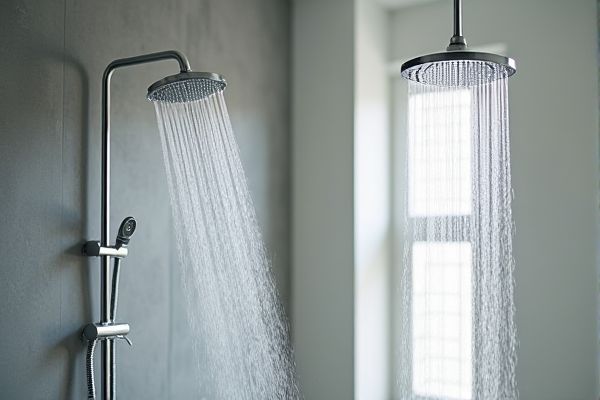
Low-flow showerheads reduce water usage significantly compared to standard showerheads by using advanced technology to maintain strong water pressure while conserving water and energy. Explore the rest of this article to discover how choosing the right showerhead can improve Your bathroom efficiency and lower utility bills.
Table of Comparison
| Feature | Low-Flow Showerhead | Standard Showerhead |
|---|---|---|
| Water Flow Rate | 1.5 to 2.5 gallons per minute (GPM) | 2.5 to 5.0 gallons per minute (GPM) |
| Water Efficiency | High - reduces water usage by up to 40% | Lower - higher water consumption |
| Energy Savings | Significant - lowers heating costs due to less hot water use | Minimal - higher water and energy usage |
| Water Pressure | Maintains adequate pressure with efficient design | Typically strong pressure but uses more water |
| Environmental Impact | Reduced water waste and energy consumption | Higher environmental footprint due to greater resource use |
| Cost | Moderate initial cost with long-term savings | Often lower upfront cost but higher utility bills |
| Installation | Simple, fits standard plumbing | Standard installation |
| Certification | Often WaterSense certified | Usually no certification |
Introduction: Low-Flow vs. Standard Showerheads
Low-flow showerheads reduce water usage by 40-60% compared to standard showerheads, using around 1.5 to 2.0 gallons per minute (GPM) instead of the typical 2.5 GPM. These devices help conserve water and lower utility bills while maintaining sufficient water pressure through advanced aeration technology. Standard showerheads offer a higher flow rate but contribute to increased water consumption and energy costs over time.
Water Usage and Conservation
Low-flow showerheads use approximately 1.5 to 2.5 gallons of water per minute, significantly reducing water consumption compared to standard showerheads that typically use 2.5 to 5 gallons per minute. This reduction in water usage plays a crucial role in water conservation efforts, helping households save thousands of gallons annually. By lowering water flow without compromising pressure, low-flow showerheads minimize environmental impact and contribute to sustainable resource management.
Energy Efficiency Comparison
Low-flow showerheads typically use 1.5 to 2.0 gallons per minute (GPM), compared to standard showerheads that consume 2.5 GPM or more, resulting in significant water and energy savings. Reduced water usage directly lowers the energy required to heat the water, with low-flow models cutting water heating energy consumption by up to 30%. This efficiency translates into lower utility bills and a reduced environmental footprint, making low-flow showerheads a key component in sustainable bathroom upgrades.
Cost Analysis and Savings
Low-flow showerheads typically cost between $15 and $50, while standard models range from $10 to $30, but the higher initial investment is offset by significant water and energy savings. You can reduce water consumption by up to 40%, leading to lower utility bills and a faster return on investment, especially in areas with high water costs. Over time, the savings from decreased water heating and usage can amount to hundreds of dollars annually, making low-flow showerheads a cost-effective and environmentally friendly choice.
Performance and Water Pressure
Low-flow showerheads are engineered to deliver sufficient water pressure while using significantly less water, conserving up to 50% of water compared to standard showerheads. Advances in design, such as aerating technology and pressure-compensating flow control, ensure low-flow models maintain a strong, consistent spray that enhances shower performance despite reduced flow rates. Your experience remains comfortable and efficient, combining water savings with effective rinsing power.
Installation and Compatibility
Low-flow showerheads are designed for easy installation, typically fitting standard shower arms and requiring no special tools, making them compatible with most existing plumbing setups. Standard showerheads may vary more in size and connection types, sometimes needing adapters for installation. Your choice of showerhead should consider the ease of installation and compatibility with your current bathroom fixtures to ensure a hassle-free upgrade.
Environmental Impact
Low-flow showerheads reduce water consumption by up to 50% compared to standard showerheads, significantly lowering your household's water footprint. This reduction conserves freshwater resources and decreases energy usage associated with heating water, helping to lower greenhouse gas emissions. Choosing a low-flow option supports environmental sustainability by minimizing water waste without sacrificing performance.
User Experience and Comfort
Low-flow showerheads reduce water usage while maintaining strong water pressure through advanced aeration technology, ensuring your shower experience remains comfortable and refreshing. Standard showerheads often use more water but may provide a higher, consistent flow rate that some users prefer for relaxation. Choosing a low-flow showerhead balances eco-friendly efficiency with a satisfying shower, enhancing your comfort without sacrificing performance.
Maintenance and Longevity
Low-flow showerheads require less frequent cleaning due to reduced mineral buildup from lower water flow, which enhances their longevity compared to standard showerheads. Standard showerheads often need more maintenance to prevent clogging and corrosion caused by higher water pressure and volume. Selecting a low-flow showerhead can help you minimize maintenance efforts and extend the lifespan of your bathroom fixtures.
Choosing the Right Showerhead for Your Needs
Low-flow showerheads reduce water consumption by up to 50%, saving an average of 2.5 gallons per minute compared to standard models that use around 5 gallons per minute. These environmentally friendly fixtures maintain sufficient water pressure while lowering utility bills and conserving resources. Selecting a showerhead depends on balancing water efficiency, pressure preferences, and budget to match your specific household needs.
 homyna.com
homyna.com